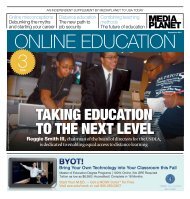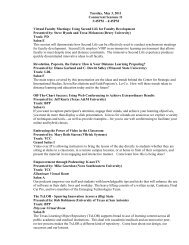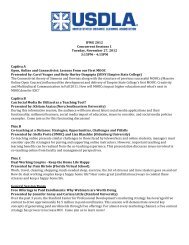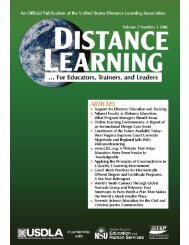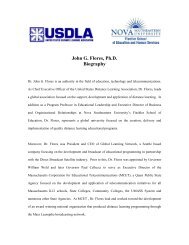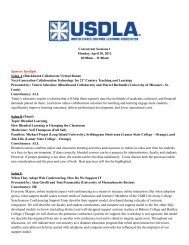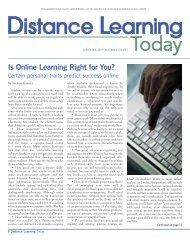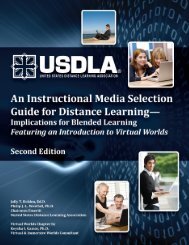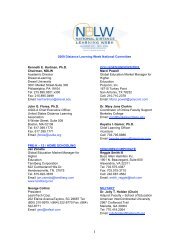United States Distance Learning Association
United States Distance Learning Association
United States Distance Learning Association
- No tags were found...
Create successful ePaper yourself
Turn your PDF publications into a flip-book with our unique Google optimized e-Paper software.
4. Limiting the enrollment in distance<br />
learning sections, ensuring equivalence<br />
in teaching loads for distance<br />
learning and face-to-face instructors,<br />
limiting the use of teaching assistants<br />
and adjuncts for distance learning<br />
courses. At present it seems that universities<br />
are really running the risk of<br />
reducing the potential effectiveness of<br />
distance learning by finding ways to<br />
reduce cost for delivery of courses in<br />
this format. They override class size<br />
conventions, exceeding the 25:1 ratio<br />
that is usually present in face-to-face<br />
instruction. They expect faculty who<br />
teach online to teach more, rather than<br />
less, sections (even though it is often a<br />
more labor-intensive teaching<br />
approach). They have more distance<br />
learning courses taught by teaching<br />
assistants and adjuncts than face-toface<br />
courses.<br />
QUESTION: Is higher education in the<br />
midst of a revolution as they embrace distance<br />
education or have administrators been seduced<br />
by potential enrollment numbers and more dollars<br />
I have a terrible record with predicting<br />
the future, but I would guess a little bit of<br />
both. I think much of distance learning is<br />
pushed by numbers and dollars. However,<br />
I think higher education is in the midst of a<br />
revolution—and distance learning is part<br />
of that. There is little continued tolerance<br />
for the prevalence of graduates exiting<br />
with few marketable or worthwhile skills.<br />
Competing models (corporate universities,<br />
community colleges, etc.) are forcing<br />
higher education to reevaluate what they<br />
do and how they do it.<br />
QUESTION: There is a documented trend in<br />
universities, at least in the <strong>United</strong> <strong>States</strong>,<br />
which shows a great deal of resistance by faculty<br />
to teaching online. How can we overcome that<br />
resistance<br />
A couple of different ways:<br />
1. Allow faculty to move through gradually—going<br />
from Web-supported to<br />
fully online instruction.<br />
2. Providing adequate pre-, during- and<br />
postcourse support to faculty teaching<br />
online.<br />
3. Finding ways to reassure faculty that<br />
their intellectual property in the<br />
course design is not compromised<br />
through putting their course material<br />
in published format on university<br />
servers.<br />
4. Limiting class sizes and teaching loads<br />
in distance learning—right now distance<br />
learning has the reputation of<br />
being the ultimate way in which faculty<br />
can be overburdened.<br />
QUESTION: Because of the shortage of qualified<br />
online instructors, universities will often<br />
hire a professor fresh from a graduate program<br />
to teach. Should these people be required to<br />
acquire practical experience in a subject matter<br />
area before being allowed to teach or is access to<br />
an SME good enough<br />
Your suggestion would certainly help<br />
improve the quality and relevance of university<br />
teaching, so I would very much<br />
support it. However, the reality is that the<br />
majority of faculty at universities have<br />
been career professors, with no experience<br />
in the outside world for 20-30 years. Perhaps<br />
there should be more of a requirement<br />
for all teachers to demonstrate that<br />
they are continuing to get “real-world”<br />
experience throughout their teaching<br />
experience.<br />
QUESTION: Research shows that students<br />
select online courses mostly for convenience’s<br />
sake. Should students be dissuaded from thinking<br />
of distance learning as an educational<br />
shortcut<br />
I think the main challenge here is misinformation.<br />
Convenience may be the initial<br />
Volume 4, Issue 4 <strong>Distance</strong> <strong>Learning</strong> 81



